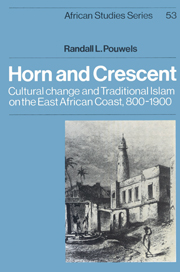Book contents
- Frontmatter
- Contents
- List of illustrations and maps
- Preface
- List of abbreviations
- Introduction
- 1 The roots of a tradition, 800–1500
- 2 The emergence of a tradition, 900–1500
- 3 A northern metamorphosis, 1500–1800
- 4 Town Islam and the umma ideal
- 5 Wealth, piety, justice, and learning
- 6 The Zanzibar Sultanate, 1812–88
- 7 New secularism and bureaucratic centralization
- 8 A new literacy
- 9 The early colonial era, 1885–1914
- 10 Currents of popularism and eddies of reform
- Notes
- Glossary
- Bibliography
- Index
3 - A northern metamorphosis, 1500–1800
Published online by Cambridge University Press: 23 September 2009
- Frontmatter
- Contents
- List of illustrations and maps
- Preface
- List of abbreviations
- Introduction
- 1 The roots of a tradition, 800–1500
- 2 The emergence of a tradition, 900–1500
- 3 A northern metamorphosis, 1500–1800
- 4 Town Islam and the umma ideal
- 5 Wealth, piety, justice, and learning
- 6 The Zanzibar Sultanate, 1812–88
- 7 New secularism and bureaucratic centralization
- 8 A new literacy
- 9 The early colonial era, 1885–1914
- 10 Currents of popularism and eddies of reform
- Notes
- Glossary
- Bibliography
- Index
Summary
The purpose of this chapter is to examine the oral traditions of the northern coast dating from the sixteenth to the eighteenth centuries to see what they reveal about the evolution of northern coastal culture and religion in the early ‘modern’ period. Since much of this history centred on changes introduced when high-status immigrants settled among a local social core of ‘Shirazi’, it is important, first, to briefly review who or what these Shirazi represent in coastal traditions. Next, some attention will be given to information available from external (Arabic and Portuguese) sources concerning the nature of these immigrants and the impact they made on East African societies. Finally, a particular effort will be made to elucidate the meanings of the northern (especially Lamu) traditions themselves in light of the previous two sections.
THE SHIRAZI
The history and character of coastal towns, of course, developed not only from the relationships obtained with their natural environments, but also from those established among the various groups of people who settled the towns. A primary social ingredient of each town was a core of relatively ancient descent groups who were in fact often spread throughout several villages and towns of an entire region. These autochthonous clans underpinned larger economic, social, and political communities which might be characterized as confederations, alliances, or city-states. The ultimate unity of such communities of settlements depended on the type and degree of cooperation and coordination there was among these locally acknowledged indigenous ‘families’.
- Type
- Chapter
- Information
- Horn and CrescentCultural Change and Traditional Islam on the East African Coast, 800–1900, pp. 32 - 62Publisher: Cambridge University PressPrint publication year: 1987



